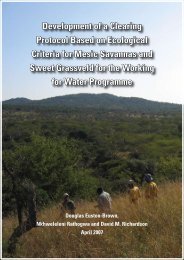Metsi Consultants - DWA Home Page
Metsi Consultants - DWA Home Page
Metsi Consultants - DWA Home Page
You also want an ePaper? Increase the reach of your titles
YUMPU automatically turns print PDFs into web optimized ePapers that Google loves.
Step 2: Optimisation of the preferred IFR<br />
Report No 678-F-001<br />
METSI CONSULTANTS: SUMMARY OF MAIN FINDINGS FOR PHASE 1 DEVELOPMENT<br />
Once the bulk allocation of water to be made available for IFRs has been made, the optimal allocation should be<br />
made to achieve the best environmental outcome. This would require hydrological modelling of system reservoir<br />
and allocation of water to low flows and floods for the best environmental outcome using the biophysical data<br />
collected during the course of this study.<br />
Step 3: Formal agreement to the IFR<br />
This stage involves agreement of all parties involved on IFR releases considering the output of Step 2. While the<br />
outcome of Step 2 could lead to an agreed IFR, the implementation of IFR operationally would need formal<br />
agreement.<br />
After an agreement had been reached on IFR releases, the reservoir operation plans would need to be prepared.<br />
This is referred to as the annual plan of operation, which will provide boundaries for operation of all completed<br />
reservoirs including the Matsoku Diversion. Releases to meet the agreed IFR will depend on reservoir inflows and<br />
prevailing reservoir storage levels, information on which needs to be updated on a weekly basis. The annual plan<br />
of operation may require updating over time, depending on precipitation and the reservoir inflows.<br />
Establishment of an acceptable IFR is but one step in the overall management of the LHWP and cannot be<br />
effectively implemented in isolation. Decisions on IFR implementation will have to take cognisance of several<br />
inescapable facts:<br />
Katse Dam has been completed to a design that seeks near-maximum diversion of Malibamats'o River<br />
flows, makes minimal provision for downstream ecosystem maintenance, and has little flexibility or<br />
capacity for maintaining downstream IFRs.<br />
Mohale Dam and Matsoku Weir are nearing completion to designs which permit somewhat more leeway<br />
than Katse Dam in setting realistic release schedules but which are still highly constraining, e.g., Mohale<br />
Dam cannot release more than a 1:2 year flood.<br />
The current LHWP Phase 1 compensation programmes, embedded in the respective Environmental<br />
Action Plans, are restricted to the immediate catchments above Katse and Mohale dams, and it would<br />
require a major revision and considerable additional expense to extend them to encompass the relevant<br />
downstream areas.<br />
14.2. STRATEGIC APPROACH TO OPTIMISING IFRs<br />
The following strategies are recommended in meeting the first and second objectives of the decision-making<br />
process, i.e., identifying a range and optimising the eventual IFRs.<br />
Multiple objectives are suggested, including (as a priority) matching the IFRs in as many river reaches<br />
as possible to maintain as much of the river ecosystems in as good a condition as is practically and<br />
economically feasible.<br />
The upstream compensation programmes should be evaluated and those with the highest rates of<br />
success used as a basis for extension into the downstream areas. Innovative thinking will be required for<br />
programmes that have not been tested over time.<br />
The status quo is a logical starting point, i.e., Katse Dam completed and operational, Mohale and<br />
Matsoku being constructed with specific limitations on their release capacities (Annex D), and the<br />
existing Treaty in force with its downstream release stipulations and conditions for maintaining<br />
environmental quality and well being of affected communities.<br />
The system under study would best be partitioned for more effective application of mitigation (permitting<br />
an adequate IFR) and planning of compensation; partitioning would optimally be achieved:<br />
80

















